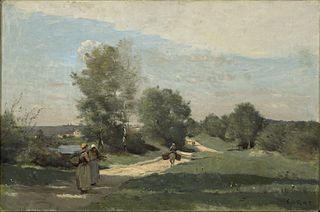The Cemetery of Montmartre is a cemetery in the 18th arrondissement of Paris, France, that dates to the early 19th century. Officially known as the Cimetière du Nord, it is the third largest necropolis in Paris, after the Père Lachaise Cemetery and the Montparnasse Cemetery.

The Prix de Rome or Grand Prix de Rome was a French scholarship for arts students, initially for painters and sculptors, that was established in 1663 during the reign of Louis XIV of France. Winners were awarded a bursary that allowed them to stay in Rome for three to five years at the expense of the state. The prize was extended to architecture in 1720, music in 1803 and engraving in 1804. The prestigious award was abolished in 1968 by André Malraux, then Minister of Culture, following the May 68 riots that called for cultural change.

The Barbizon school of painters were part of an art movement toward Realism in art, which arose in the context of the dominant Romantic Movement of the time. The Barbizon school was active roughly from 1830 through 1870. It takes its name from the village of Barbizon, France, on the edge of the Forest of Fontainebleau, where many of the artists gathered. Most of their works were landscape painting, but several of them also painted landscapes with farmworkers, and genre scenes of village life. Some of the most prominent features of this school are its tonal qualities, color, loose brushwork, and softness of form.

Alexandre Cabanel was a French painter. He painted historical, classical and religious subjects in the academic style. He was also well known as a portrait painter. According to Diccionario Enciclopedico Salvat, Cabanel is the best representative of L'art pompier, and was Napoleon III's preferred painter.

The Minister of Worship was a cabinet member in the Government of France responsible for overseeing the French government's relationship with religions. An area of particular attention was the Roman Catholic Church's role in public education, and the portfolio of Minister of Worship was frequently combined with "Minister of Public Education". After the founding of the Third Republic in 1871, the Jules Ferry laws and the 1905 law on the separation of the State and the Church, the Minister of Worship was combined with the Minister of Interior. Thus, it is in that quality that the previous Interior Minister Nicolas Sarkozy created in 2003 the CFCM.
Events from the year 1800 in France.
The following is a chronological list of classical music composers who lived in, worked in, or were citizens of France.
Capitale & Victor ORLY is a French gallery established by the cultural association Capitale in Marseille, France, in 2005. The gallery presents works of international contemporary artists. The gallery is managed by Guennadi Grebniov.